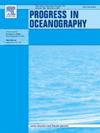北大西洋东部环流间区长达十年的气流反转
IF 3.6
3区 地球科学
Q1 OCEANOGRAPHY
引用次数: 0
摘要
在过去二十年里,在北大西洋东部中纬度地区的伊比利亚北部/西北部观测到两次水文变化,揭示了被称为间环流区的弱循环水库的对比行为。2005年,强烈的冬季混合导致北大西洋中部水域核心水位(300-500米)对应的中深度盐度突然增加,从而将该水体转变为更咸/更密集的品种。这种转变在更大的范围内改变了空间密度场,导致该地区传统上被描述为向南流动并为副热带环流提供食物的地区经历了持久的流动逆转。这种逆转使该地区进入了更温和、更咸的类似南方的环境,并削弱了比斯开岛南部上升流的强度。2014年,自20世纪90年代初以来首次观测到新鲜和冷却,这一过程在接下来的几年里得到了加强,同时还恢复了向南流动和比斯开岛南部上升流的条件。长达十年的逆流阶段意味着,由于气候变化对生态系统的影响,正在进行的经向化趋势在时间上得到了促进,而随后传统环流的恢复使该地区回到了典型的北方特征。讨论了这一奇异逆模环流事件在较大时间尺度上的唯一性或可能的重现性。本文章由计算机程序翻译,如有差异,请以英文原文为准。

A decade-long flow reversal in the intergyre region of the eastern north Atlantic
Two hydrographical shifts observed within the last two decades around north/northwestern Iberia, in the mid-latitudes of the eastern North Atlantic, reveal a contrasting behaviour of the weakly circulating reservoir known as the intergyre region. In 2005, a strong winter mixing caused an abrupt salinity increase at mid-depths corresponding to East North Atlantic Central Waters core levels (300–500 m), thus transforming this water mass into a saltier/denser variety. Such shift altered spatial density fields on a broader scale, causing this region classically described as flowing southwards and feeding the subtropical gyre to experience a lasting flow reversal. The reversal brought the region into milder and saltier southern-like conditions and weakened the strength of upwelling in southern Biscay. In 2014, freshening and cooling was observed for the first time since the early 1990s, a process enhanced in the following years accompanied by the restoration of southwards flow and southern Biscay upwelling conditions previously known. The decade-long reversal flow stage meant a temporal boost of ongoing meridionalisation trends attributed to climate change affecting ecosystems, while subsequent recovery to traditional circulation brought the region back to a classical more boreal character. We discuss the uniqueness or possible recurrence on larger timescales of this singular reversed mode circulation event.
求助全文
通过发布文献求助,成功后即可免费获取论文全文。
去求助
来源期刊

Progress in Oceanography
地学-海洋学
CiteScore
7.20
自引率
4.90%
发文量
138
审稿时长
3 months
期刊介绍:
Progress in Oceanography publishes the longer, more comprehensive papers that most oceanographers feel are necessary, on occasion, to do justice to their work. Contributions are generally either a review of an aspect of oceanography or a treatise on an expanding oceanographic subject. The articles cover the entire spectrum of disciplines within the science of oceanography. Occasionally volumes are devoted to collections of papers and conference proceedings of exceptional interest. Essential reading for all oceanographers.
 求助内容:
求助内容: 应助结果提醒方式:
应助结果提醒方式:


